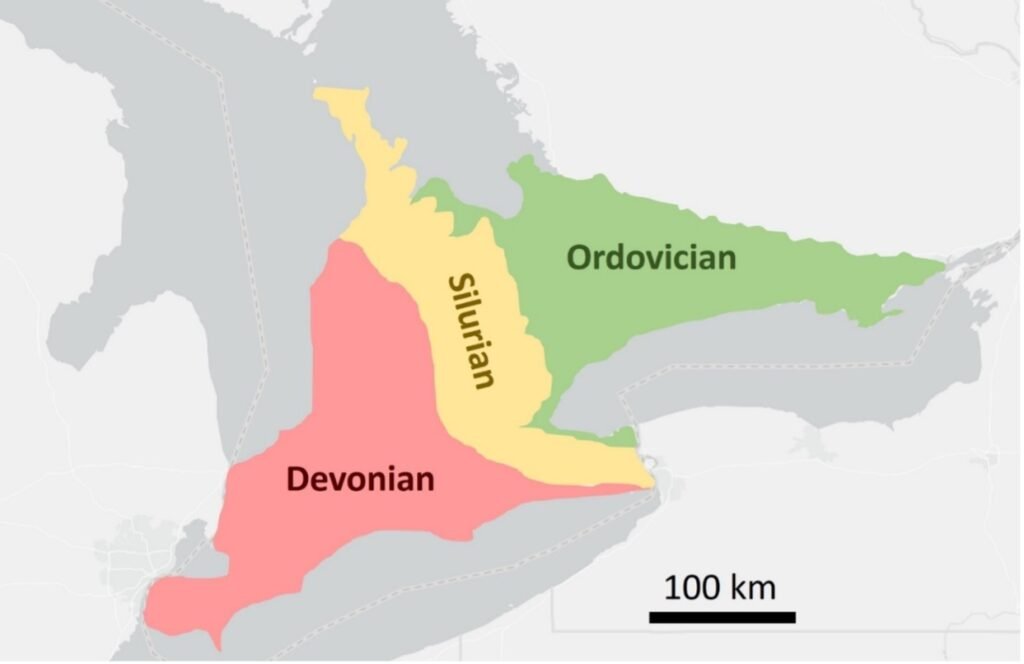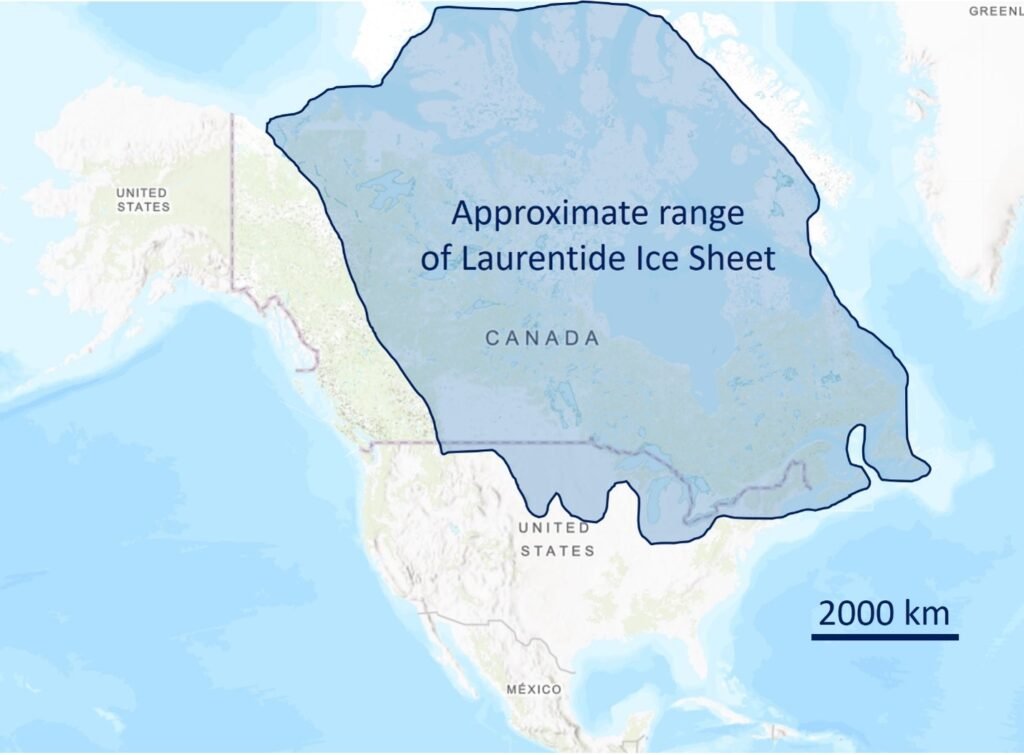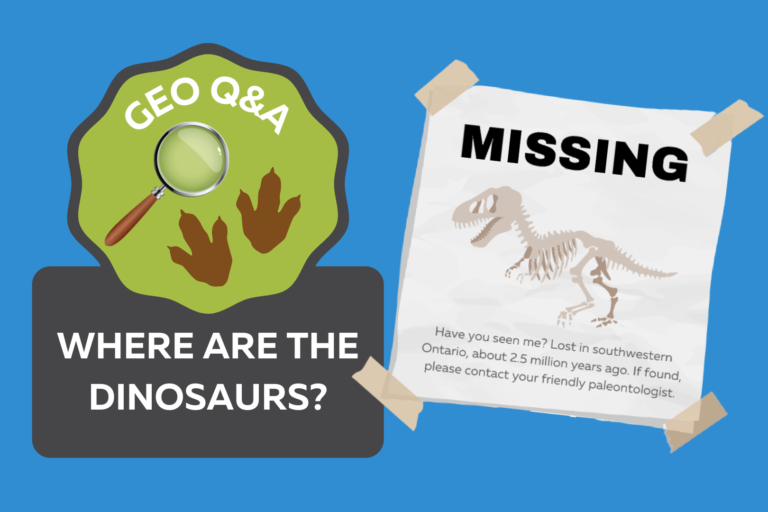Dinosaurs were some of the biggest animals to ever roam our planet. This massively large group of reptiles were around from the late Triassic Period (approximately 230 million years ago) until they went extinct at the end of the Cretaceous Period, approximately 65.5 million years ago (not including their flying descendants, which evolved into today’s birds!). For a remarkable 165 million years, they were seemingly ubiquitous; dinosaur fossils have been found on every continent! When dinosaurs first evolved, Earth’s plates were arranged into one large continent called Pangea. This single-continent arrangement no doubt facilitated their migration to all corners of the globe. It should stand to reason therefore that if I start digging in my backyard here in London, Ontario, I should eventually find some kind of dinosaur fossil, should it not? Turns out, the answer is a disappointing no.

Only disappointing, though, if dinos are your only area of interest. Don’t get me wrong, I love dinosaurs (although I would not want to meet one in a back alley. Or even a front alley); however, there is still a treasure trove of fossils just waiting to be uncovered here in Ontario. The fossils here are just much, much older than any dinosaur, because the time they lived in and thus the rocks that their remains eventually became fossilized within are much older. The rocks in southwestern Ontario range in age from the late Ordovician Period (about 455 million years) to the Late Devonian Period (about 360 million years). That is roughly 205-130 million years before the first dinosaur strutted on the scene! If there are no dinosaur fossils to be found in southwestern Ontario, does this mean that dinosaurs never lived here at all?

Fear not. Ask any paleontologist, and they will all agree that dinosaurs almost certainly did live in what is now Ontario, Canada. The Mesozoic Era, sometimes colloquially called the Age of the Dinosaurs, lasted approximately 165 million years. During such a long geological time span, there were no doubt times of deposition that added to the rock record. Given that there would have been many billions of individual dinosaurs during that time, the remains of many little and big critters would have absolutely been buried in the sediments and later undergone fossilization across Ontario. So, the big question remains: where are the dinosaurs?

Up until about 2.5 million years ago, these fossilized dinosaur bones were likely still in the rocks in southern Ontario, just waiting to be discovered by future paleontologists. But then something big happened. Something really big. Things started to get very cold. Global temperatures began to drop significantly, and ice sheets started to grow on the continents. The cause of this change to colder conditions isn’t as clear as you’d think for something that occurred relatively recently (at least in geological terms that is). If you ask three different respected geologists why, you might get three slightly different respectable answers. That doesn’t mean that two of them are wrong, it just means that the cause is likely a result of an interplay of different factors that all contributed to lower global temperatures. The position of Earth’s continental plates no doubt played a big factor in the overall cooling of the planet, as their arrangement greatly affects oceanic and atmospheric circulation patterns. Other variables such as atmospheric CO2 levels and even predictable changes to Earth’s orbit could have facilitated the cooling process.
In North America, the Laurentide ice sheet covered most of Canada and some parts of the United States a number of times, as it advanced and retreated repeatedly in cycles of growth and shrinkage in response to climatic conditions. You can imagine the havoc that a sheet of ice reaching a few kilometres in thickness would have on the ground as it makes its way forward and backward! The ice sheet literally scraped many layers of rock away, turning whatever got in its way into a fine powder called “rock flour”. All those poor dinosaur fossils that waited so patiently to get their place of honour in a paleontology museum were instead ground up into dust.

Far be it from the scientific community to see this as a bad thing. Although glacial activity removed the fascinating rocks layers of the dinosaur-saturated Mesozoic Era here in Ontario, it ended up exposing the just-as-fascinating rock layers of the even older Paleozoic Era! The rocks that lie at or near the surface in southwestern Ontario range in age from the Upper (or late) Ordovician Period (about 455 million years old) around the Belleville to Peterborough area and get progressively younger as you drive southwest towards the Arkona area, where they are late Devonian in age (about 360 million years old). Although the fossils found in these rocks differ among species, there are many common types of fossils found in many of the limestone, dolostone, and shale outcrops throughout southwestern Ontario, from Ordovician to Devonian rock units.

Limestone rock unit in Arkona, Ontario that is rich in Devonian fossils. 
Rugose coral from Devonian period, found at Arkona, Ontario.
Some of the most common types of fossils found in southwestern Ontario are corals. Although they look like plants, corals are actually marine animals that usually lived attached to the seafloor. The fossilized corals here in southwestern Ontario are either tabulate (colonial-type) or rugose (solitary and colonial type) corals, and if you find them, it can tell you quite a bit about what the environment was like when they were alive. Since they thrive in relatively shallow, warm, marine seas, we can reconstruct their living conditions and make some accurate conclusions about the environment when these rock units were deposited. There are also many other fossils to be found in these rocks, such as brachiopods, gastropods, bivalves, crinoid parts, trilobites, bryozoans, and much more. The animation here shows what life could have looked like in the shallow, tropical seas of the Devonian Period, in southwestern Ontario.
This is all fine and dandy, but the question still remains: where are the dinosaurs? To find them, you’ll need either a good-working car or a plane ticket; however, you don’t need a passport. Canada has its own dinosaur treasure chest in Alberta. If you visit Dinosaur Provincial Park (what a cool name), which has the high honour of being a UNESCO World Heritage Site, you can immerse yourself in a Late Cretaceous dinosaur graveyard. Don’t forget to visit the Royal Tyrrell Museum while you’re in the province, as it has an impressive collection of dinosaur fossils and is an on-going research facility that is well worth your time. Remember to also explore the “Trail of the Fossil Hunters”.

The surficial geology of Canada is fascinatingly complex and changes drastically from coast to coast. As such, the fossils within these rock layers may differ in age by hundreds of millions of years, depending on where you look. Our fossils in southwestern Ontario may not have roared voraciously when they were alive, but that makes them no less important!
To read more about what life looked like in southwestern Ontario during the Paleozoic Era, visit our Arkona Story Map. Here, you will be immersed in a virtual learning experience that describes all the fossils found here, how these Devonian fossils lived, what the environment looked like, and at what latitude southwestern Ontario was located during that time.

Deana Schwarz, P.Geo., is the Manager of Public Education Programs at GeoscienceINFO.com. She has Bachelor degrees in Geology and Biology, an M.Sc. in Geology, and a Ph.D. in Geology from the University of Western Ontario.

